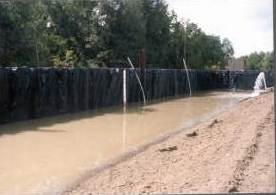
In 1985, the Corps of Engineers Division HQ initiated a sheet pile test, called the E-99 study in the Atchafalaya Basin near Morgan City. Photo/courtesy of Dr. Robert Bea
After Hurricane Katrina, the Army Corps of Engineers told major media, including the New York Times, that New Orleans officials played a contributing role in the failure of flood walls along the city’s drainage canals and the resulting catastrophic flooding. For years, top brass and Corps PR spokespersons spread this consistent message regarding the failure of the 17th Street and London Avenue Canals and the flooding of the city’s main basin.
Now, in a response to a records request submitted by the grassroots group Levees.org, the Corps of Engineers admits that it cannot produce any data to support the claim.
“It is not possible to determine exactly which documents…were relied upon, considered, reviewed, read or discussed,” responded Ken Holder, Public Affairs Chief for the Corps’ New Orleans District.
Instead, Mr. Holder’s letter, released today, suggests review of an independent 333-page study called the Hurricane Protection Decision Chronology prepared for the Corps and published in March 2008.
Interestingly, buried deep in the report is a stunning analysis showing that pre-Katrina, the Corps of Engineers had misinterpreted one of its own studies, the so called E-99 study. Decisions made as a result led to the flooding of the city’s main basin where there is the highest concentration of people, property and infrastructure.
Apparently, in 1985, the Corps of Engineers Division Headquarters initiated a Sheet Pile Test in the Atchafalaya Basin near Morgan City, a region with soils similar to those in New Orleans. According to Chronology, the Corps executed the study improperly and wrongly concluded that:
“…when foundation soils were poor, sheet pile penetration depth beyond a certain point would not significantly increase I-wall stability under the type of short-term loading conditions believed to characterize hurricane events….”
In other words, the Corps determined it only needed to drive sheet piles down to depths of 17 feet instead of between 31 and 46, believing that “sheet pile penetration beyond a certain depth would not improve wall stability and therefore was a wasteful expenditure.”
This switch by the New Orleans District to significantly shorter sheet piles saved the District $100,000,000.
And on August 29, 2005, the newly raised floodwalls along the 17th Street and London Avenue canals slid laterally, fell over and led to direct residential, commercial and public property flooding damage in excess of $27 billion in the city’s main basin.
“The shallow sheet pile depths led directly to the two levee breaches on the London Avenue Canal, and to the north breach of the Inner Harbor Navigation Channel by the the Lower Ninth Ward, and they contributed to the levee breach at the 17th Street Canal” says Dr. Ray Seed, co-chair of an independent post-Katrina analysis underwritten by the U.S. National Science Foundation.
“The storm surge was still more than four feet below the tops of the flood walls at all four of these sites at the times of the levee failures. Deeper sheet piles would likely have prevented these catastrophic failures”, said Dr. Seed in a statement this week.
Levees.org has long believed that unsupported defamatory statements made by senior corps officials suggesting that New Orleans agencies played a role in the 2005 flooding may have harmed southeast Louisiana’s recovery by alienating the nation’s citizens and ultimately prejudicing members of Congress.
The statements were particularly audacious in light of the botched E-99 study.
In January 2008, the U.S. District Court, Eastern District of Louisiana placed responsibility for the flood wall collapses and resulting flood in downtown New Orleans squarely on the Army Corps of Engineers, but the agency was found not financially liable due to the sovereign immunity established by the Flood Control Act of 1928.





[…] a horrific flood event due to tragic mistakes made by the Army Corps of Engineers. At a savings of $100 million, the Corps decided to drive sheet piles down only 17 ft instead of 45. This was a tragic human […]